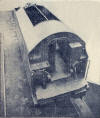
Author














John Senior
| Upon
its formation in 1923 the London Midland & Scottish Railway inherited
dynamometer cars from the London & North Western and Lancashire & Yorkshire
railways, which had been completed in 1909 and 1913 respectively. Of the
two, the L&YR vehicle was the more sophisticated, but both measured drawbar
pull in terms of the deflection of a powerful spring and in 1928 the
accuracy of the former became suspect on account of hysterisis (although it
continued in service until 1967).
During the 1930's the LMS planned elaborate new locomotive testing facilities, including a new comprehensive test train (known as the Mobile Test Plant) and the Locomotive Testing Station at Rugby which was a joint project with the LNER. Both railways planned new dynamometer cars and ordered three Swiss Amsler hydraulic dynamometers, the third for incorporation in the stationary test plant at Rugby. Construction of the new LMS dynamometer vehicle commenced at Derby C&W Works shortly before the outbreak of war in 1939, but it was not completed until a decade later, soon after the formation of British Railways in January 1948. Initial trial runs were made in late April 1949 and it ultimately made 1,086 scheduled test runs between May 1949 and July 1975, covering an estimated 147,616 miles. Although originally designed to test steam locomotives, in the event it was also employed to evaluate diesel and electric locomotives and also the Prototype High Speed Train on the East Coast Main Line in June 1973. During its working life this vehicle has carried several liveries, i.e. BR 'blood and custard' , BR maroon and latterly the BR Research Department 'Red and Blue'. Restored in 1979 it has been lettered LMS in recognition of its origins although not actually completed until after Nationalisation in 1947. The above information is provided - courtesy of the National Railway Museum. It is now cosmetically restored into its former LMS livery and has recently (June 2011) moved from Barrow Hill to the MRC at Butterley, Derbyshire. A number of tests were carried out with the London Midland (LM) Region Mobile Test Plant which enabled tests to be conducted on the road at constant speed.A description of the Mobile Test Plant The Mobile Test Plant comprised the LM Region No.3 Dynamometer Car M45049, Mobile Test Units Nos. 1, 2 and 3 M45053, M45054 and M45055 and a special locomotive corridor tender which were all designed and built by the LMS at Derby C&W Works in 1938 but not completed until after WW2. The main Instrument Room in the Dynamometer Car, accommodated the Control Desk for the Mobile Test Units, as well as housing the Amsler Recording Table which provided a continuous record of speed, drawbar pull, horsepower etc. The various multi-point thermometers, draught gauges etc. were also housed in this room. A smaller room, the Indicator Compartment, contained a Farnborough Indicator which furnished indicator cards on a crank angle base, whilst another compartment contained apparatus for continuous smoke box gas sampling during tests.
The Mobile Test Units, were electrically braked
vehicles equipped with generators
which could automatically keep the speed constant, irrespective of gradient, by
varying the load as required. Externally they were identical but the gearing and
electrics were designed for different speed ranges, these were up to 50, 90 and
120 mile/h, although they could and usually were, used in any combination. The special tender was equipped with a coal space and a corridor. The coal space would be used for test coal in one hundredweight (cwt.) bags, (approx. 50 kg) and for loose coal required for periods not under test and for standby purposes. A water meter was fitted to give the amount of water taken from the tender. Look here for a contemporary account of the MTU in action. Here are some pictures of the units which made up the Mobile Test Plant taken from the early BR test bulletins and the official pictures of them in Derby C&W Works when new. All photos are from the author's collection except where indicated otherwise |